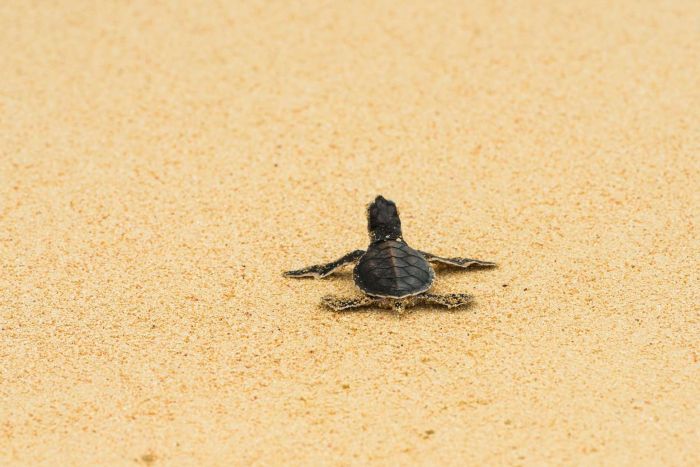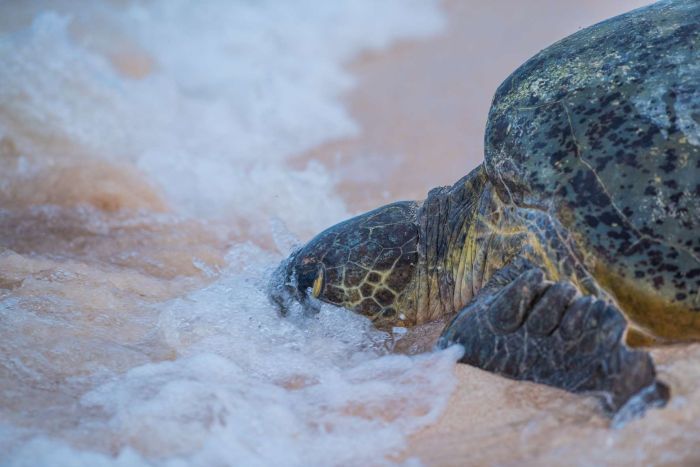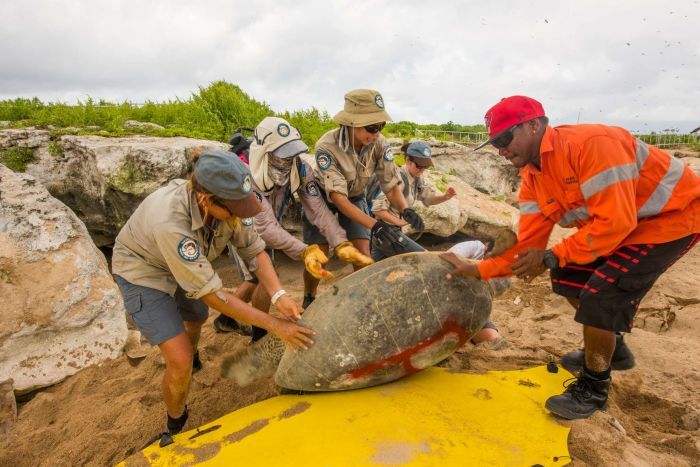Turtles nesting on 'Galapagos of Australia' receive helping hand in bid for survival
Updated
 Photo:
Turtles are battling rising sea levels and overcrowding on Raine Island, off the Queensland coast. (Supplied: Gary Cranitch/Queensland Museum)
Photo:
Turtles are battling rising sea levels and overcrowding on Raine Island, off the Queensland coast. (Supplied: Gary Cranitch/Queensland Museum)
The number of endangered green turtle hatchlings has more than doubled on Queensland's remote Raine Island, with the help of a bold conservation project.
The Raine Island National Park, which sits 620 kilometres north of Cairns, is the world's most important green turtle nesting site, labelled by scientists as "the Galapagos of Australia".
The ABC was given rare and exclusive access to the tiny sand island as thousands of turtles landed on the beach at night, ready to lay their eggs.
But the species is battling rising sea levels and overcrowding on the island, prompting scientists to intervene.
 Photo:
A 150m section of beach has been raised and reshaped to create more space and protect eggs. (Supplied: Gary Cranitch/Queensland Museum)
Photo:
A 150m section of beach has been raised and reshaped to create more space and protect eggs. (Supplied: Gary Cranitch/Queensland Museum)
Andy Dunstan from Queensland Parks and Wildlife is one of the few people who have access to the island and who has witnessed the impact of sea water on turtle eggs.
"Even though [this female turtle] is making a fantastic effort, laying a clutch of 100 eggs, they'll probably be flooded on the next high tide and they won't develop," Mr Dunstan said, as he watched the turtle dig in the sand.
Cramped conditions on the tiny island mean the tens of thousands of turtles that are digging to lay their own eggs each season are destroying others and disturbing hatchlings.
Mr Dunstan said sand cliffs were a problem too, but over the past 18 months, work has been done to fix that.
"The [turtles] fall off the low sand cliff edges here, onto their backs, and they can't right themselves so they'll just die in those positions," he said.
"But we've been fencing along the top of those cliffs, which has stopped them accessing them."
To create more space and protect eggs from flooding, a 150-metre section of beach has been raised and reshaped with great results, prompting plans to overhaul more of the island this year.
 Photo:
A live webcam has been set up on Raine Island so rangers can monitor nesting turtles. (Supplied: Gary Cranitch/Queensland Museum)
Photo:
A live webcam has been set up on Raine Island so rangers can monitor nesting turtles. (Supplied: Gary Cranitch/Queensland Museum)
"The hatching success has been a lot better in those areas. The actual production of hatchlings to the ocean has improved," Mr Dunstan said.
"This is actually a last bastion of hope and we're in a position to give some resilience to the world's green turtle population."
Traditional owner Lloyd Maza, from nearby Murray Island, said the efforts were working to boost the turtle population across the region.
"Turtles are coming up in the village all the time and I'm thinking, 'wow, this is really great'," he said.
"You save one particular area, [and] it affects every other area around it."
 Photo:
Queensland Parks and Wildlife Service staff watch over one turtle at night. (Supplied: Gary Cranitch/Queensland Museum)
Photo:
Queensland Parks and Wildlife Service staff watch over one turtle at night. (Supplied: Gary Cranitch/Queensland Museum)
Saving the turtles isn't cheap or easy
The joint program between the Queensland Government, Great Barrier Reef Foundation and BHP Billiton is expected to cost nearly $8 million over five years.
The Great Barrier Reef Foundation's Anna Marsden was cautiously optimistic about the results so far.
"No two hatchling seasons are the same, next year could yield different results," she said.
"We'll only know the true success that the re-profiled land and other habitat restoration has had in a few years' time, but it does show this level of intervention is having an impact."
The Queensland Government is launching a website to help the public monitor the team's progress.
"Raine Island is incredibly remote and very hard to get to and even if you could get to it, you need a special permit to be there," Environment Minister Steven Miles said.
"Now anyone in Queensland or right around the world can see what's going on at Raine Island, with a live webcam so people can see what our rangers are up to and see how many turtles are nesting."
 Photo:
Only a limited number of people are allowed on Raine Island at any one time. (Supplied: Gary Cranitch/Queensland Museum)
Photo:
Only a limited number of people are allowed on Raine Island at any one time. (Supplied: Gary Cranitch/Queensland Museum)
Topics: human-interest, animals, environment, conservation, animal-science, science-and-technology, cairns-4870, qld, australia
First posted







